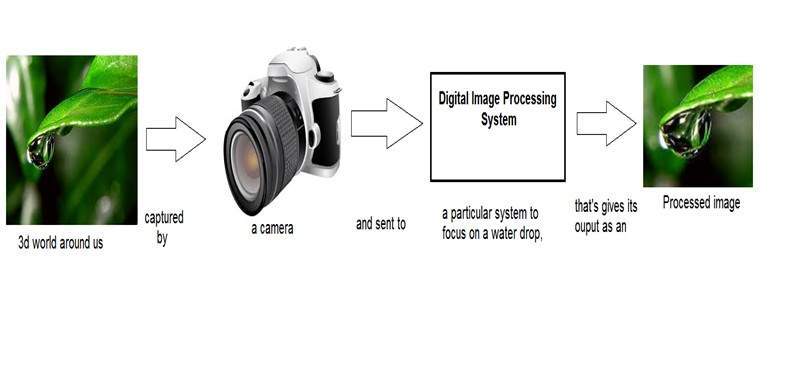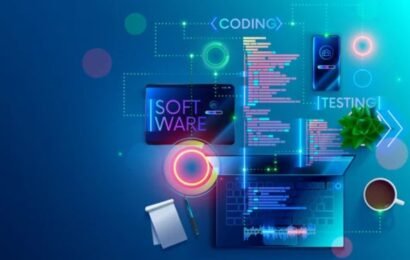
- Instructor: Heidi Sommer
- Lectures: 48
- Students: 2051
- Duration: 10 weeks
Digital image processing deals with manipulation of digital images through a digital computer. It is a subfield of signals and systems but focus particularly on images. DIP focuses on developing a computer system that is able to perform processing on an image. The input of that system is a digital image and the system process that image using efficient algorithms, and gives an image as an output. The most common example is Adobe Photoshop. It is one of the widely used application for processing digital images.
How it works.

In the above figure, an image has been captured by a camera and has been sent to a digital system to remove all the other details, and just focus on the water drop by zooming it in such a way that the quality of the image remains the same.
Free Certification
Academy Europe presents high-quality formal diplomas, certificates and e-certificates which are formal proof and recognition of accredited online courses. It shows all student’s abilities to learn and achieve high results and is very useful to promote personal career including with CVs, job applications and self improvements.
How can you get your certificate at Academy Europe?
- You must click “complete” link at the end of every lesson of your course after you finish them.
- When you finish all lessons of course, the “finish course” link is going to be active at the end of last lesson.
- When you click the “finish course” link, you will finish your course on Academy Europe officially. Then, “certificate” page of you completed course will be automatically active.
- You can see and download your certificate online after you click on your “certificate” link.
Samples: Horizantal Diploma – Horizantal Certificate – Vertical E-Certificate



Prerequisites
Signals and systems
Since DIP is a subfield of signals and systems , so it would be good if you already have some knowledge about signals and systems , but it is not necessary. But you must have some basic concepts of digital electronics.
Calculus and probability
Basic understanding of calculus , probability and differential equations is also required for better understanding.
Basic programming skills
Other than this, it requires some of the basic programming skills on any of the popular languages such as C++ , Java , or MATLAB.
Before you start proceeding with this course on Academy Europe, we are assuming that you have a good aptitude and can think logically. You should want to try something different.
Ideal candidates for the course would typically possess:
– Discipline and attentiveness
– Ability to conduct research
– Ability to perform tasks with speed, efficiency, and accuracy
– Analytical judgment
– Patience to interpret technical/scientific data
– A willingness to learn, roll up your sleeves and work toward your dream!
– A computer, tablet or smartphone and an internet connection
– Basic computer skills
Audience
This tutorial gives you the knowledge of widely used methods and procedures for interpreting digital images for image enhancement and restoration and performing operations on images such as (blurring , zooming , sharpening , edge detection , e.t.c). It also focuses on the understanding of how the human vision works. How do human eye visualize so many things , and how do brain interpret those images? The tutorial also covers some of the important concepts of signals and systems such as (Sampling , Quantization , Convolution , Frequency domain analysis e.t.c).
This course by Academy Europe aims at imparting quality education and training to students.
Academy Europe is dedicated to its students, their specific learning requirements, and their overall learning success.
This course is directed toward a student-centered, independent study, asynchronous learning approach.
After completing this course on Academy Europe, students will get self improvement and promotion in their careers.
This course is based on at least two learning skills which are provided to the users through audio & visuals, videos, verbal presentations and articles, all of which are asynchronized with distance education approach.
Curriculum
- 48 Sections
- 48 Lessons
- 10 Weeks
- Digital Image Processing Introduction1
- Signals and Systems Introduction1
- History of Photography1
- Applications and Usage1
- Concept of Dimensions1
- Image Formation on Camera1
- Camera Mechanism1
- Concept of Pixel1
- Perspective Transformation1
- Concept of Bits Per Pixel1
- Types of Images1
- Color Codes Conversion1
- Grayscale to RGB Conversion1
- Concept of Sampling1
- Pixel Resolution1
- Concept of Zooming1
- Zooming Methods1
- Spatial Resolution1
- Pixels, Dots and Lines Per Inch1
- Gray Level Resolution1
- Concept of Quantization1
- ISO preference curves1
- Concept of Dithering1
- Histograms Introduction1
- Brightness and Contrast1
- Image Transformations1
- Histogram Sliding1
- Histogram stretching1
- Introduction to Probability1
- Histogram Equalization1
- Gray Level Transformation1
- Concept of Convolution1
- Concept of Mask1
- Concept of Blurring1
- Concept of Edge Detection1
- Prewitt Operator1
- Sobel Operator1
- Robinson Compass Mask1
- Krisch Compass Mask1
- Laplacian Operator1
- Introduction to Frequency domain1
- Fourier Series and Transform1
- Convolution Theorem1
- High Pass vs Low Pass Filters1
- Introduction to Color Spaces1
- Introduction to JPEG Compression1
- Optical Character Recognition1
- Computer Vision and Computer Graphics1





